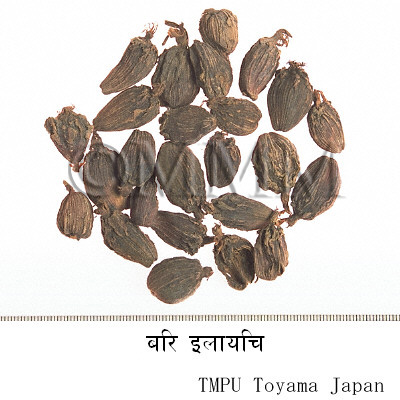Crude drug sample data base
※Click on the image to enlarge it.
Crude drug name | Market name | Bari elachi |
|---|---|---|
| Formal name | Bhadrela | |
Other names Tips! | Baraelayechi (T), Borilachi (B), Baraelayechi (H), Doddaelakkay (K), Valiya elattari (M), Pedda yelakayulu (Te), Periya elakkayi (Ta), Patrela (Ti), Alainci (N) | |
| English name | Greater Cardamom, Nepal Cardamom | |
| Original plant name | Amomum subulatum Roxb., Greater Cardamom, Nepal Cardamom | |
| Family name | Zingiberaceae | |
| Used part | Classification | Plant origin | Sub classification | fruit |
| Collection information | India, New Delhi | |
| Collection date | 1986/11/07 | |
| Collector | Tsuneo Namba, et al. | |
| TMPW No. | 5528 | |
The capital city, provincial capital city or the representative
location of its administrative area is indicated.
location of its administrative area is indicated.
Production area information
https://ethmed.toyama-wakan.net/img/pin_san.png
28.6139391
77.20902120000005
Collection information
India,New Delhi
https://ethmed.toyama-wakan.net/img/pin_nyu.png
Scientific information data base
| Crude drug name | Ayurvedic name or Sanskrit name, English name | Bhadrela, Greater Cardamom, Nepal Cardamom | |||
|---|---|---|---|---|---|
| Synonyms | Brhadela, Sthulaila, Sugandhika, Tridiva, Tridivodbhuta, Prthvika, Kanyaka, Puta, Bahula, Candrabala, Niskuti, Surabhitvak, Mahaila, Kanya, Kumarika, Indri, Kayastha, Goputa, Kantha, Ghrtaci, Garbhasambhava, Indrani, Divyagandha | ||||
| crude drug image |
| ||||
| Original plant name | Amomum subulatum Roxb. | ||||
| Family name | Zingiberaceae | ||||
| Used part | Seeds | ||||
| Distribution area | Cultivated in swampy places along the sides of mountain streams in Nepal, Bengal, Sikkim, Assam and Eastern Himalayas. | ||||
| Remarks | Under cultivation only. | ||||
| Common uses | Fruits of Bhadrela are used in drugs prescribed in indigestion, vomiting, biliousness and stomatitis. Seeds are credited with stomachic, stimulant, alexipharmic and astringent properties and are prescribed for the treatment of indigestion, vomiting, biliousness, abdominal pains and rectal diseases. Seeds promote elimination of bile and are useful in congestion of liver. In large doses (30 grains) with quinine, they are useful in neuralgia. They are also used in gonorrhoea/gonorrhea. The pericarp is used in headache. Seeds' decoction is used as a gargle in affections of teeth and gum, congestion of liver and abdominal pain. Oil from the seeds is aromatic, stimulant, stomachic and is applied to eyelids to cure inflammation. With melon seeds they are used as a diuretic in cases of gravel of the kidneys. | ||||
| Therapeutic uses | Asyavairasya (distaste in the mouth), Pittasra (bleeding disorders), Kandu (itching), Svasa (respiratory diseases), Trt (thirst), Hrllasa (feeling of melting of heart), Visa (poison), Vasti (urinary disorders), Siroruk (headache), Asyaruk (pain in the mouth), Vami (vomiting), Kasa (cough), Vrana (wounds) | ||||
| Chemical constituent | Monoterpenoids 1,8-Cineole (*C1), alpha-Terpineol (*C1), alpha-Pinene (*C1), beta-Pinene (*C1), allo-Aromadendrene (*C1) Phenol derivatives Protocatechualdehyde (*C2), Protocatechuic acid (*C2), 1,7-Bis(3,4-dihydrophenyl)hepta-4E,6E-dien-3-one (*C2), 2,3,7-Trihydroxy-5-(3,4-dihydroxy-E-styryl)-6,7,8,9-tetrahydro-5H-benzocycloheptene (*C2) | ||||
| Medical system | Ayurveda (Traditional Indian medicine) | ||||
| Traditional concept | Rasa (Taste) | Katu (Pungent), Tikta (Bitter) | |||
| Virya (Potency) | Usna (Hot) | ||||
| Guna (Quality) | Ruksa (Dry), Laghu (Light), Tiksna (Sharp) | ||||
| Vipaka (Post digestive taste) | Katu (Pungent) | ||||
| Karma (General action) | Dipani (increasing digestive fire), Pacana (digestive), Garbhavisodhana (post-partum purificant), Mukhamastakasodhini (clearing mouth and head) | ||||
| Dosakarma (Action on dosa) | Decreases Kapha, Pitta | ||||
| Mala (Action on excretory mechanism) | Recana (Laxative) | ||||
| Avayava (Action on organ) | Vasti (bladder), Sira (head), Asya (mouth) | ||||
| Traditional usage | 1. Harenuka (Amomum subulatum) and Pippali (Piper longum) in equal parts should be taken with curd for cough. 2. Harenuka pounded with the juice of flowers of Amra (mango) and Jambu (Syzygium cumini) mixed with honey and ghee should be used as collyrium in cases of day and night blindness. 3. Harenuka is included in Agurvadya taila (a formulation) efficacious in fever with cold. 4. Decoction of Pippali, Sariva (Hemidesmus indicus), Draksa (grapes), Satapuspa (Anethum sowa), Harenuka mixed with jaggery alleviates fever causes by Vata. 5. Harenuka is one of the ingredients of Mahakalyanaka ghrta (a formulation) used for insanity. | ||||
| Formulation | Agurvadya taila, Mahakalyanaka ghrta, Trsahara curna. | ||||
| Comments | Synonyms like Brhadela, Sthulaila, Mahaila all these refer to the bigger nature of it compared to Ela (Eleteria cardamomum). Sugandhika, Surabhitvak, Divyagandha refer to the strong odour. | ||||
| References | Reference book Tips! | [2] Indian Medicinal Plants - A Compendium of 500 species, Varier, P.S., Orient Longman Ltd. Chennai (Madras) Vol. 1 (Repr.1996), pp 128-131. Glossary of Indian Medicinal Plants, 1956. Chopra, R.N., Nayar, S.L. and Chopra, I.C., Council of Scientific & Industrial Research, New Delhi. - New Edition (1996) National Institute Science Communication; Supplement p 16. Illustrated Manual of Herbal Drugs Used in Ayurveda, 1996. Sarin, Y.K., Council of Scientific & Industrial Research and Indian Council of Medical Research, New Delhi p 280. Plants in Ayurveda (A Compendium of Botanical and Sanskrit Names), 1997. Abdul Kareem, M., Foundation for Revitalisation of Local Health Traditions, Bangalore 116. Dravyagunavijnana, Vols. 1-5, reprint 1998. Sharma, P.V., Chowkhambha Bharati Academy, Varanasi Vol. 2, pp 729-730. Classical uses of Medicinal Plants, 1996. Sharma, P.V., Chaukhambha Visvabharati, Varanasi p 412. | |||
| Research paper | *C1 Gurudutt, K. N., Naik, J. P., Srinivas, P. and Ravindranath, B.; Flavour Fragrance J., 11, 7-9 (1996). *C2 Kikuzaki, H., Kawai, Y. and Nakatani, N.; J. Nutri. Sci. Vita., 47, 167-71 (2001). | ||||
| Last renewal date | 2023/11/16 | ||||



